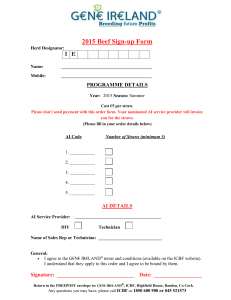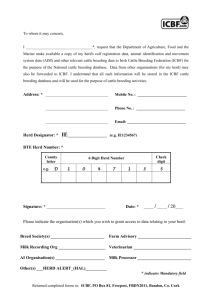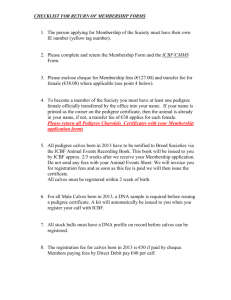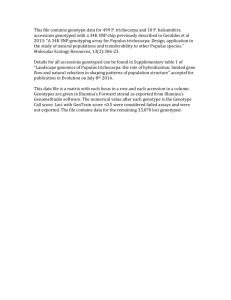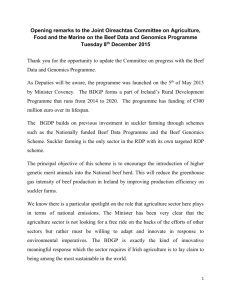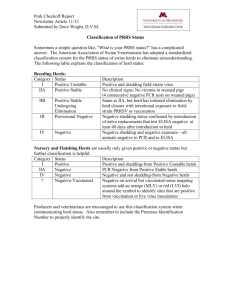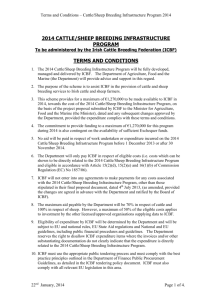FAQs from BDGP Information Meetings
advertisement
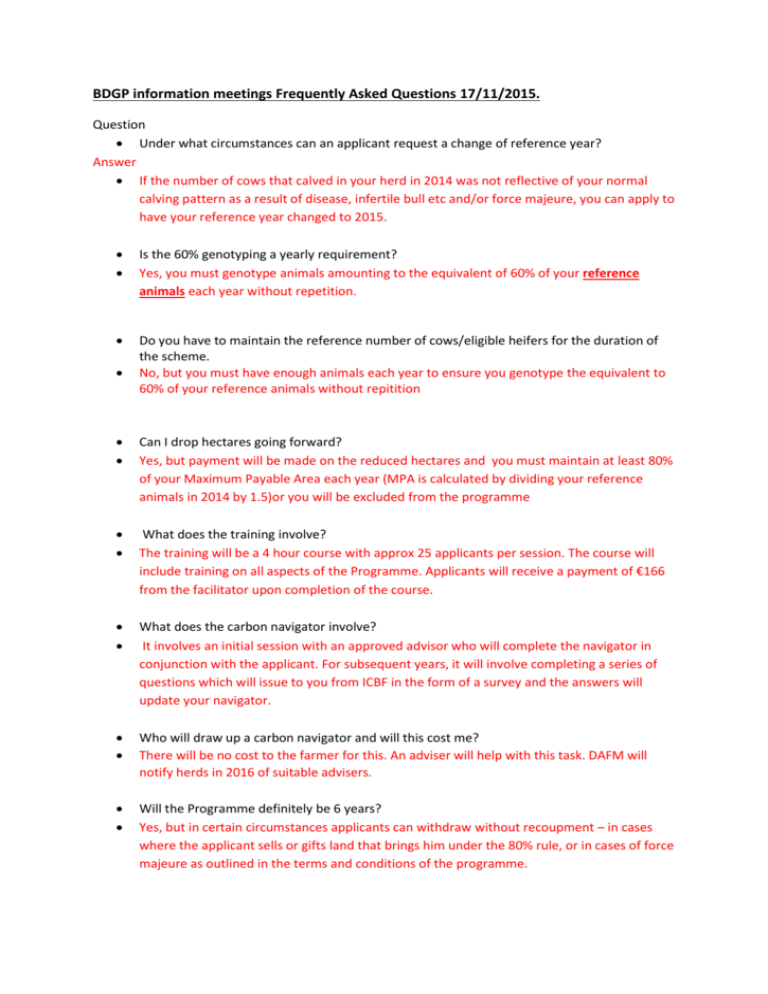
BDGP information meetings Frequently Asked Questions 17/11/2015. Question Under what circumstances can an applicant request a change of reference year? Answer If the number of cows that calved in your herd in 2014 was not reflective of your normal calving pattern as a result of disease, infertile bull etc and/or force majeure, you can apply to have your reference year changed to 2015. Is the 60% genotyping a yearly requirement? Yes, you must genotype animals amounting to the equivalent of 60% of your reference animals each year without repetition. Do you have to maintain the reference number of cows/eligible heifers for the duration of the scheme. No, but you must have enough animals each year to ensure you genotype the equivalent to 60% of your reference animals without repitition Can I drop hectares going forward? Yes, but payment will be made on the reduced hectares and you must maintain at least 80% of your Maximum Payable Area each year (MPA is calculated by dividing your reference animals in 2014 by 1.5)or you will be excluded from the programme What does the training involve? The training will be a 4 hour course with approx 25 applicants per session. The course will include training on all aspects of the Programme. Applicants will receive a payment of €166 from the facilitator upon completion of the course. What does the carbon navigator involve? It involves an initial session with an approved advisor who will complete the navigator in conjunction with the applicant. For subsequent years, it will involve completing a series of questions which will issue to you from ICBF in the form of a survey and the answers will update your navigator. Who will draw up a carbon navigator and will this cost me? There will be no cost to the farmer for this. An adviser will help with this task. DAFM will notify herds in 2016 of suitable advisers. Will the Programme definitely be 6 years? Yes, but in certain circumstances applicants can withdraw without recoupment – in cases where the applicant sells or gifts land that brings him under the 80% rule, or in cases of force majeure as outlined in the terms and conditions of the programme. What happens if I want to pull out of the Programme in 3 years? If the reason for withdrawal is other than specified in previous paragraph payments already made under the Programme will be recouped. However as outlined above there are flexibilities built into the scheme design to provide for withdrawal in the event of land sales, leasing or certain other circumstances. Calculation of payment. Payment will be made on a per hectare basis subject to a maximum payable area (MPA) which is calculated by dividing the number of reference animals by 1.5 Payment of €142.50 will be made on the first 6.66 hectares with a payment of €120.00 on the remaining hectares. Will I be paid on 2015 if I am successful in my request for a reference year change? Yes, but payment will not issue until the Department can confirm the number of calved cows in 2015. This will be in February 2016 when all registrations have been recorded. Payments will commence for this group in March 2016. Why have I not gotten any correspondence from the Department to date? There are still a very small number of cases where approval letters have not yet issued. The Department will issue these letters in the next week. Do I have to keep the calves for a required period? You must keep the calf for five months. However, if the survey forms are not received by the time the calf is five months old record the data and proceed with the sale if you wish Do I have to put genotype tested animals in calf to qualify? No Can I select the animals to be genotyped? For the first year, given the time constraints, the ICBF have selected the animals and you can only request a replacement animal if a nominated animal died or has been slaughtered etc. From 2016, you will be able to nominate some animals that you wish to genotype or change those nominated by the ICBF. Can the BVD tag be used to genotype also. Currently, the tags have separate functions, however, going forward the plan is to have one tag capable of taking both BVD and genotype samples. This will not happen until 2017 at the earliest. If my son/daughter/partner/spouse takes over my farm in 2016/2017 can he/she apply to participate in the Programme? There is no need to apply as he can just continue to adhere to the requirements that you signed up to. However the transferee will have to complete a form of undertaking that he/she will continue with the obligations under the scheme. When will payment issue? Payments will commence in December 2015 to herds where all samples have been sent to the laboratory and all surveys completed and returned When can farmers be expected to see euro-star replacement information available in mart sales? ICBF are working with the marts to make this information available and farmers can expect to see it available in marts over the next 12 months, with the first of the marts likely to rollout in next 1-2 months. Is it possible to print off a page or statement from ICBF to bring to a sale to prove, or highlight, four or five star heifers (rated on the replacement index) I am selling? Yes. Herds participating in the BDGP and herds that are members of HerdPlus can log in to www.icbf.com (contact ICBF if you do not know your password). Herdplus members can view animals in their Euro-Star Profile (live listing of all animals). Herds that are not members of HerdPlus but that are participating in BDGP can generate a new BDGP Euro-Star Report by clicking on Reports, BDGP Euro-Star, Generate New Report. This report can be created as often as desired (especially useful if a herd has bought in new animals or has had calves born recently). I tagged most of the animals identified for tagging but forgot to tag one weanling before sale. Will I be penalised for this error or can I take a sample from another animal? The requirement of the scheme is to genotype 60% of your reference number. Herds must sample and return 60% each year. If animals are dead or sold when tagging, the herd-owner should contact ICBF 1850 625 626 to order a sample kit for a replacement animal. Bulls are considered for inclusion to the scheme on a within or across breed basis. I am told heifers are only considered on a within breed basis. Is this the case and why? Only purebred animals have within breed stars. All animals have across breed stars. Purebred animals (bulls or females) can qualify on the Within or Across breed stars. Commercial animals (cross-bred) qualify on across breed stars only. This is because they have no within breed category on which to compare them, i.e., they are a consolidation of all beef breeds. If a farmer purchases a four or five star animal that is subsequently genotyped and reduces in value to a one, two or three star, can the Department of Agriculture or ICBF confirm that the purchasing farmer cannot contest the sale of the animal and return it? No, he cannot contest the sale of the animal. He purchased the animal at a point in time with a given €uro-Star evaluation. That evaluation will change over time as more information becomes available on the animal and its relatives, e.g., genomic data, new performance records etc. Whilst the recent BDGP reports have given farmers a picture of their 4 and 5 star animals, it is not until the next iteration of the reports (Spring 2016) that DAFM expect to be in a position to start to deem animals as “eligible” for the purpose of the scheme, i.e., that they have been genotyped and are 4 or 5 stars on the relevant index (as per the T&C’s of the scheme). I purchase my replacement heifers at weanling stage as I like to ensure I have time to take necessary health precautions and have them ready for bulling in spring to calve at 24 months of age. What is the likelihood of four and five star heifers dropping in value when genotyped? Can I genotype these heifers myself between now and breeding next spring so I do not have to go to the expense of putting them in-calf and then find they may not be eligible? Herd-owners can expect some animals to move from being eligible (i.e., 4/5 stars on replacement index) as a weanling to being ineligible as a calved in replacement heifer (i.e., less than 4/5 stars). Initial work by ICBF would suggest that this figure is 20-25%. Regardless of whether there was a BDGP scheme or not, this is a simple outcome of the €uro-Star evaluation process, as more performance data as well as genomic data gets added into the picture for each individual animal. What herd-owners really need to remember, is that whilst some animals may go down an equal and opposite number will come-up, across the national population. Therefore, they do not have to be overly concerned about this issue. It is a natural consequence of the €uro-Star evaluation process, and the fluctuations will balance themselves out over the 6-year duration of the scheme. In terms of when will ICBF have an operational system in place (for additional animals, including animals to be bred for the first time in 2016), we anticipate having this in place for Spring 2016, ahead of the main breeding season. If pedigree animals are already genotyped (hair follicle) on the farm, or before they arrive, do they have to be done again as part of the scheme? Animals will only ever be genotyped once. Some breed societies take hair samples for parentage verification (micro satellite analysis). This is not genotyping. These animals will need to be sampled again. Is it possible for me to pay to get my heifers genotyped, though I am not participating in the scheme? Whilst priority will be given to existing BDGP herds, ICBF expects to be in a position to offer a service to all beef herds later in 2016. As part of that service, herd-owners will be able to select and pay for animals to be genotyped. At this stage, no price has been confirmed but ICBF expects it to be higher than the €22/animal negotiated for BDGP herds. What is the accuracy of genotyping and by how much is it likely to lift reliability levels? The process of genotyping is very accurate, provided that a high quality sample of DNA has been provided by the herd-owner. In terms of the increase in reliability, work undertaken by Teagasc and ICBF has suggested an increase in reliability for the replacement index from the current 20% (based on just parent average data) to some 30% (based on parent average and genomic data). This will be during the initial roll-out of the indexes (Spring 2016). Thereafter, as more data and genotypes accumulate (over the 6 years of the program), ICBF expects the figure to increase from the current 20% to approximately 50%. Do I need to sell one, two or three star replacement heifers if I am in the scheme? Can I bring some lower value replacements into the herd (or retain some lower star cows) as long as I reach overall targets? No, herds do not need to sell any animals. They do not need to sell lower star animals. If the herd wishes to breed replacements to meet the scheme requirements from lower star animals they should use a high replacement index bull/AI. The targets are 20% in 2018 and 50% in 2020; as a result a herd can most certainly have lower star animals in their herd. Also another option is to buy in high index replacement Heifers before the target dates in 2018 and 2020. When are the first evaluations incorporating genotype information targeted for publication? Spring 2016. Most my cows are first cross Limousin and angus that I buy and bucket rear. They have no Eurostar information and I am told this is because they have no sires recorded. Can I ring the owners and get the information or would genotyping these animals pick up the sires from any database? Yes, this farmer should try to find out the sire where possible. Many herds have one stock bull so in many cases the original breeder will be able to help. Any missing sires can be recorded online at www.icbf.com. Where this is not possible or the sire cannot be found, sires (in many cases) will be identified as a result of genotyping. Once the sire is added animals will have euro-star rating. If I get out of cows, can I meet the requirements of the scheme by buying in heifers and genotyping a new batch each year? A herd is required to have 60% (of reference animals) to genotype every year. Where a herd does not have enough females to genotype each year, males will be selected. In 2018 (20%) and 2020 (50%), the herd must have the required number of females (over 16 months, genotyped and 4-5 star). If I am buying a bull should I wait until he is genotyped or can I ask the farmer to genotype and wait to see that he qualifies? How long would it take for a result to come back on this? Genomic evaluations will be made available to herd-owners in Spring 2016. In scenarios where herd-owners are looking to buy a bull (or females) ahead of Spring 2016, then they are advised to try and purchase animals with high indexes (i.e., 5 stars on the relevant index) so as to give some leeway for a potential drop in the animals proof as more data accumulates over the next number of months. If I have further questions/clarifications, whom should I contact? Department of Agriculture Food and the Marine Phone: 0761064423 Email: Beefschemes@agriculture.gov.ie Irish Cattle Breeding Federation Phone: 1850625626
